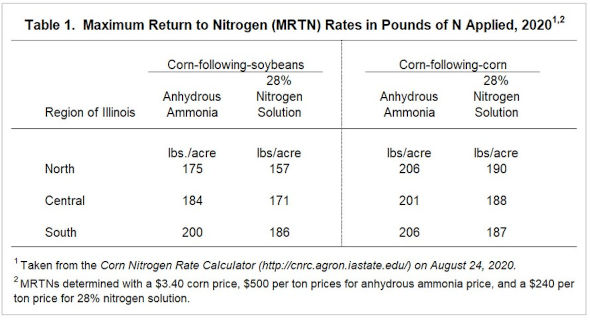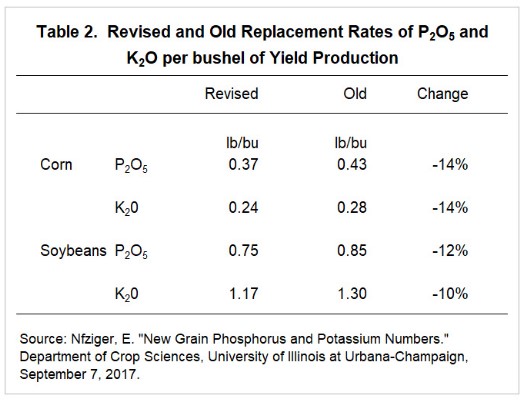By Gary Schnitkey and Sarah Sellars
Department of Agricultural and Consumer Economics
By Laura Gentry
Department of Natural Resources and Environmental Sciences
University of Illinois
Many farmers could experience greater financial returns by reducing fertilizer rates. Many farmers apply nitrogen at rates above those recommended by land grant university research. Moreover, in 2017, UIUC university researchers reduced the long-held guidelines for phosphorus and potassium uptake by corn and soybean crops. Herein, we show potential cost savings achievable as a result of reducing nitrogen, phosphorus, and potassium fertilization rates for corn and soybean production. Capturing these returns is particularly important now given the low and negative margins for corn and soybean production.
Nitrogen for corn
The University of Illinois uses the “Maximum Return to Nitrogen” (MRTN) recommendation system for nitrogen application rates in the
Corn Nitrogen Rate Calculator, a website maintained by universities in Corn Belt states. MRTN calculates the nitrogen fertilizer application rate that, over time, will produce the greatest economic returns for nitrogen use. More description of the MRTN are available
here.
Table 1 shows MRTN rates for northern, central, and southern Illinois and are given for “corn-following-soybeans” and “corn-following corn” cropping rotations. In central Illinois, for example, the MRTN for corn-following-soybeans with anhydrous ammonia as the source of nitrogen is 184 pounds per acre. The rate is reduced to 171 pounds per acre when a 28% nitrogen solution is used to provide nitrogen. These MRTN rates were generated using prices of $3.40 per bushel for corn, $500 per ton for anhydrous ammonia, an $240 per ton for a 28% nitrogen.

Many farmers apply nitrogen fertilizer at rates above the MRTN recommendation. Precision Conservation Management (PCM) is a farmer service program designed to help farmers make financially-based conservation decisions (see PCM results
here). PCM tracks field passes and input applications on over 300,000 acres of agricultural land in east-central Illinois. Of fields enrolled in PCM, 55% applied at nitrogen rates over MRTN. For those 55% of fields, the application rate averaged 39 pounds per acre more than MRTN solution (click
here for paper).
Reducing rates by 39 pounds per acre would result in savings to farmers. Given an anhydrous ammonia price of $400 per ton, those farmers could have reduced nitrogen costs by $9 per acre. Generally, anhydrous ammonia is the lowest-cost source of nitrogen. Higher cost savings are possible if 28% nitrogen solution is used. Given a $240 per ton price for 28%, the savings would be $17 per acre. The MRTN does not consider timing of nitrogen fertilizer application (fall vs. in-season) as a calculation input.
Phosphorus and Potassium for Corn
In 2017, the University of Illinois released revised guidelines for grain removal rates for phosphorus and potassium, with the revised removal rates lower than the old removal rates (See Table 2). For example, the revised removal rate for Phosphorus (P2O5) in corn is .37 pounds per bushel, which is 14% less than the old .43 pounds per bushel guideline. The potassium (K20) removal rate for corn was reduced by 14%, with the revised rate being .24 pounds per bushel compared to the old rate being .28 pounds per bushel.

Applying fertilizer at the revised rates will lower costs by approximately 14%, roughly the same amount as the reduction in removal rates. Table 3 shows the calculation of the impacts of this reduction, given that corn yield is 220 bushels per acre, roughly the trend yield for high-productivity farmland in Central Illinois. Nutrient needs are meet with diammonium phosphate (DAP) and potash having prices of $400 per ton for DAP and $350 per ton for potash. At those levels, the old replacement rates have a cost of $59 per acre, while the new rates have a $50 cost, a reduction of $9 per acre.
Phosphorus and Potassium for Soybeans
Soybean removal rates were lowered as well, with the new removal rates being .75 pounds per bushel for P2O5 and 1.17 pounds per bushel for K2O. Given a soybean yield of 60 bushels per acre, DAP and potash costs covering removal are $40 per acre, compared to $45 per acre under old removal rates (see Table 4), a cost savings of $5 per acre.
Summary
Many farmers could reduce costs significantly by reducing nitrogen applications to MRTN rates and using the new replacement rates for phosphorus and potassium. Some farmers could reduce costs by over $20 per acre for corn fertilizers. Even farmers that apply at MRTN for corn could see savings if phosphorus and potassium are applied at old replacement rates. In Central Illinois, those cost savings could be at $9 per acre for corn and $5 per acre for soybeans. These cost savings will also increase profitability. In these times of low and negative margins, these cost savings will be significant.
Source : illinois.edu